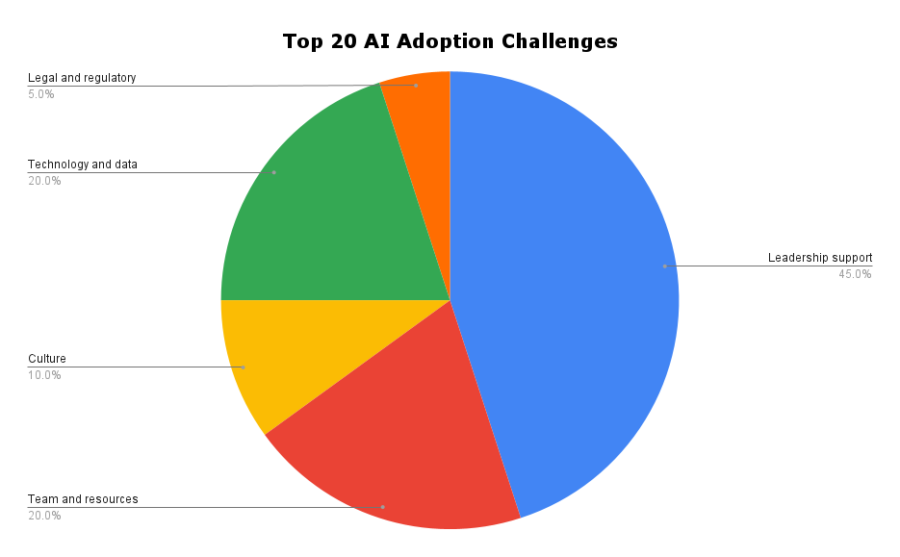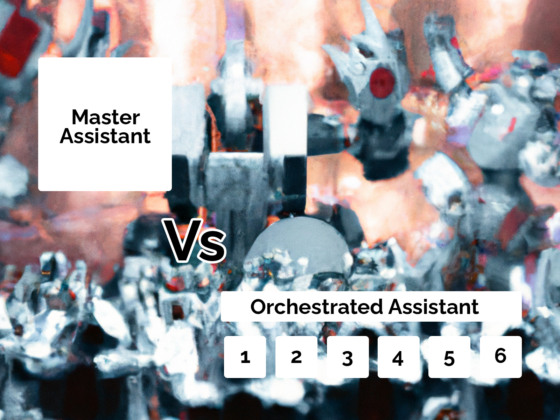Here are the top 20 AI adoption challenges from over 50 organisations that took part in a series of workshops I ran with Cognigy.
I recently facilitated a series of workshops with Cognigy on CX maturity. We gathered two groups of business leaders together over two workshops and explored (among other things) some of the barriers preventing those organisations from developing their AI and CX maturity.
Here’s a breakdown of the top 20 challenges we found.

Leadership and stakeholder support
Most of the challenges listed related to senior leadership buy-in, education and support. After some analysis, you’ll see that one thing leads to another and so on.
1. Education. Many senior leaders aren’t educated on the value of AI.
Many have unrealistic or raised expectations of what AI is and can do. It’s surely a magic black box that solves the world’s problems, right? Or it’s a toy that has little value, surely?
Your leadership board have a million and one things to do and so aren’t fully focused on the details here. So, it’s your job to educate them. If you can’t educate them properly, you can’t have AI capabilities, and CX more broadly, fit into the company vision.
2. Vision. Inability for leadership to align on a vision.
Problems arise when leadership can’t align on a vision for the organisation. Where’s it headed? What are we getting out of bed for? If the organisation doesn’t have a clear vision and direction, you’ve got nothing to tie AI and CX to. It’s like trying to catch a fly with one hand tied behind your back.
The first thing you need to do is go back to basics, herd the cats and align everyone on what you’re all doing here, why and where you’re heading. Then, you can work out how AI can facilitate that journey.
3. Priority. Lack of priority within the organisation.
It becomes obvious, then, that if your leadership team aren’t educated, and you don’t have a clear vision to pin your initiatives to, there’s inevitably a lack of priority. Why should we do this now? Or at all?
A lack of priority is simply a symptom of leadership not understanding how AI and CX fit within the vision and future of the organisation.
4. Ownership. No ownership for AI/CX.
If AI isn’t a priority, then why would you have a dedicated person or group owning the initiative? Why would you have thought out what team is required and its remit? Where should it sit within the org?
Anyone who’s worked in any kind of transformation position in the past knows that having a lynchpin, someone at the helm, who’s sole purpose is to drive home an initiative and make it a success, is crucial.
Having a dedicated team responsible for delivery is crucial, too. Most companies that don’t have this wind up having sporadic and eventually conflicting teams working on the same stuff in various guises with no person or wider strategy to tie it all together.
5. Strategy. No clear AI strategy.
When there’s a lack of drive for AI adoption or there’s sporadic activity happening with different teams, there’s no strategy.
Your strategy should stem from your company vision and define what you’re aiming to achieve and how you’re going to get there. It should be holistic and bring teams and technology together consistently towards the same goals.
Without a clear strategy, the right hand doesn’t know what the left hand is doing. You’ll create waste, inefficiencies and won’t get the ROI and benefits you’re looking for.
6. Stalled decision making.
Stalled decision making happens when you don’t have a strategy. It’s a symptom of being lost in the dark. Decisions don’t get made because you can’t see where you’re going and you don’t know who to follow. You daren’t take a step in the dark in case you fall through the floor.
7. No Budget.
Needless to say, if all of the above isn’t in place, then why would budget be available?
8. Wider organisational support.
The person who owns the programme and the strategy is responsible for identifying the other people they need to support and enable the effort. Most businesses that lack support from the areas they need it also lack a figure head who’s job it is to gain that support. And for an AI or CX transformation programme, support you will most certainly need, from almost all business units over time.
Team and resources
The second group of challenges were related to team education and skills, as well as management of AI initiatives, workload challenges and identifying partners.
9. Delivery management.
Having the right delivery management is crucial for the success of AI programmes. Having a product owner in place who understands the aims and direction of the initiative and who can work in an agile, iterative fashion means you’ll get to delivering value quickly. One of the challenges we observed was an absence of this role.
10. Team knowledge.
You’d likely expect that in an emerging field, there’s a lack of knowledge among teams and management. Most would initially believe that the lack of knowledge organisations have on conversational AI is confined to technology. However, you require knowledge on the appropriate processes required to bring an AI initiative to life, the conversation design frameworks and best practice, data requirements and knowledge on how to measure the success or the value it can bring in the first place.
Yes, knowledge about the technology is crucial, but there’s more to it than that, which is why many organisations struggle.
11. Team skills.
Few companies have the skills required to bring AI automation initiatives to life.
That stands to reason. Skills follow knowledge. If you don’t have the knowledge required, you’re unlikely to have the skills. This is why most organisations starting out should focus on educating themselves to the point of realising what skills they need.
12. Lack of capacity.
Everybody’s busy. There’s already too much work to do without AI automation. How will we make time for this new thing?
Time will come when some of the above pieces of the jigsaw are in place. When senior leadership are educated. When the value is understood. When priority is given and budget allocated. The lack of capacity is purely a symptom of a lack of priority from the organisation.
13. Partners. Finding the right ones and dealing with incumbents.
Some companies have trouble finding the right partners or are hampered by their existing partners. There’s no questions that finding the right partners is important. You’ll require technology. You might even require resources, skills or training. Finding partners to fill those gaps for you in crucial.
You’re also likely to have incumbent providers that smell an opportunity and claim to be able to deliver what you need. Every man and his dog claims to be able to help you with conversational AI these days, but the proof is in the pudding.
Culture
In running these kind of workshops in the past for wider digital transformation initiatives, I often see a lot more challenges in the Culture category. Granted, many of the leadership challenges above could be put in the culture category. Aside from those, however, there wasn’t many cultural challenges, yet the ones we found are both commonplace among organisations undergoing transformation.
14. Processes. Existing processes can hinder automation efforts.
This is nothing new. Existing and legacy processes and systems limit all transformation progress, not just AI. This is why your CX automation efforts should go hand-in-hand with business transformation initiatives.
The conversational AI part is just the front end. It means nothing if it’s not running a process for your business operation. And most of the time, for a good conversation to happen, the process needs to be updated. Another reason why senior support is so crucial. Conversational AI programmes have the potential to completely change business processes, and you’ll need wider business support for that.
15. Silos.Teams working in silos makes delivering initiatives hard.
One thing is for sure, which is that delivering AI programmes requires collaboration from across the organisation. You’re going to need IT, HR, SMEs, Marketing, Customer Service and a whole bunch more. Everything from deciding you tone of voice, accessing systems, designing processes, implementing your assistant, everything requires others.
Even if the organisation is designed around hierarchies and silos, AI programmes need to pierce holes in those silos to get things done.
Technology and data
All transformation programmes have technological challenges and AI automation is no exception. The main challenges we observed in these workshops include:
16. Tools. Not having the right tools for the job.
Even the participants who are already working on AI initiatives identified their tooling as limited. Perhaps there’s a chatbot platform that’s limited to one channel. Maybe it’s a technical framework that confines who can use it, excluding non-coders.
Having the right tools so that the right people can work on the right things is crucial for delivering timely value and fostering collaboration. It’s also crucial for making you that you can actually do what’s needed.
17. Business systems. Limitations on current line of business systems.
If I had a penny for every time a business stalled an AI project because of the inability to integrate with core business systems, I’d have £5.63. I’ve had projects delayed by 8 months while integrations were built.
In order to achieve the levels of automation that you’re aiming for, you have to have the infrastructure that’ll enable it. Even if you’re not working on CX automation right now, one of the best things you can do to future proof your organisation is to work on putting in place infrastructure that you can connect to.
18. Technical debt.
Having sporadic or legacy systems that inhibit automation. Similar to the prior challenge, only rather than not having connectivity to business systems, many companies have so many disparate systems that the complexity of their infrastructure make their current tech stack difficult to manage as it is. Many have legacy contracts with providers who aren’t interested in making their technology simpler as their business depends on support contracts. This makes being nimble and streamlining a challenge.
19. Poor data.
Not having access to the data needed to create ML models or having poor quality data. Of course, to train your NLU models, you’ll need access to data. Data from conversations with customers. However, if you don’t have data or poor data, there are ways to generate the data you need, and plenty of ways to analyse and sort data so that you can use it. That doesn’t stop it from being a challenge.
Legal and regulatory
20. Regulations.
The final challenge was related to regulatory challenges concerning things like GDPR and other data or legislative factors. These regulations can sometimes hinder organisations from sharing data, even between internal divisions. Other times, they just need to be considered when planning your solution design or technology requirements.
Where to start
The mistake many make is that they think their AI or CX transformation efforts are stalling because it’s all about budgets or plain lack or support from leadership. They don’t realise that leadership aren’t educated. So the main thing to begin with is education.
If you can educate leadership, you can raise the priority of CX and automation. If you can raise the priority and salience of CX automation and AI among leadership, they can begin to support it.
Once leadership support it, they can make some decisions concerning who should own it, what the strategy should be and, eventually, what budget can be assigned to it.
When you rush to budgetary decisions prematurely, you end up with a bunch of point solutions, siloed efforts and a lack of ownership and direction, which impacts the effectiveness of your solutions and your ROI. When budget is set at the right time, it’ll act as a catalyst, and the rest of the pieces in this list will fall into place.
No difference between AI and other transformation initiatives
What’s interesting, is that I could have written this article about any technology. This could be an article about the internet, digital transformation, mobile, you name it. We all go through the exact same things when a new transformative technology hits the shelves.
The good news is that, if you’d been through this before, then you can do it again. And if you skipped the digital transformation wave, you have a second chance to get it right here.




